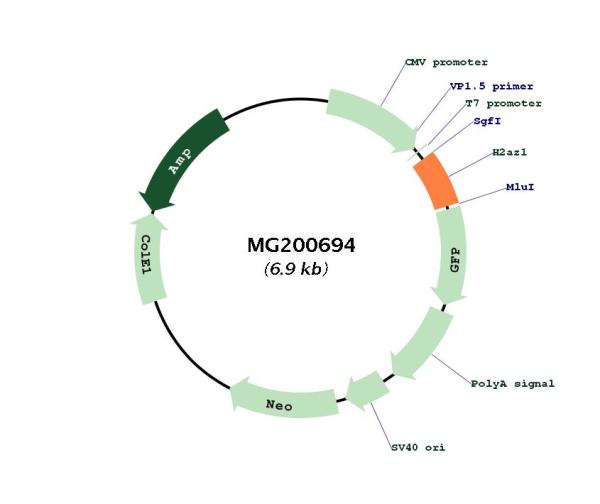H2afz (BC079903) Mouse Tagged ORF Clone
CAT#: MG200694
- TrueORF®
H2afz (tGFP-tagged) - Mouse H2A histone family, member Z (cDNA clone MGC:96771 IMAGE:30622912)
"BC079903" in other vectors (1)
Specifications
| Product Data | |
| Type | Mouse Tagged ORF Clone |
| Tag | TurboGFP |
| Symbol | H2afz |
| Synonyms | H2A.Z; H2a.z-1 |
| Vector | pCMV6-AC-GFP |
| E. coli Selection | Ampicillin (100 ug/mL) |
| Mammalian Cell Selection | Neomycin |
| Sequence Data |
>MG200694 representing BC079903
Red=Cloning site Blue=ORF Green=Tags(s) TTTTGTAATACGACTCACTATAGGGCGGCCGGGAATTCGTCGACTGGATCCGGTACCGAGGAGATCTGCC GCCGCGATCGCC ATGGCTGGCGGTAAGGCTGGAAAGGACTCCGGAAAGGCCAAGACAAAGGCGGTTTCCCGCTCGCAGCGAG CCGGCTTGCAGTTCCCTGTGGGCCGTATTCATCGACACCTGAAATCTAGGACAACCAGCCACGGACGTGT GGGCGCGACCGCCGCTGTGTACAGCGCAGCCATCCTGGAGTACCTCACCGCAGAGGTACTTGAGTTGGCA GGAAATGCGTCAAAAGACTTAAAGGTAAAGCGTATCACCCCTCGTCACTTGCAGCTTGCTATACGTGGAG ATGAAGAATTGGATTCTCTGATCAAAGCTACCATTGCTGGTGGTGGTGTCATCCCACACATCCACAAATC GCTGATCGGGAAGAAAGGACAACAGAAGACTGTT ACGCGTACGCGGCCGCTCGAG - GFP Tag - GTTTAA >MG200694 representing BC079903
Red=Cloning site Green=Tags(s) MAGGKAGKDSGKAKTKAVSRSQRAGLQFPVGRIHRHLKSRTTSHGRVGATAAVYSAAILEYLTAEVLELA GNASKDLKVKRITPRHLQLAIRGDEELDSLIKATIAGGGVIPHIHKSLIGKKGQQKTV TRTRPLE - GFP Tag - V |
| Restriction Sites |
SgfI-MluI
Cloning Scheme for this gene
Plasmid Map

|
| ACCN | BC079903 |
| ORF Size | 384 bp |
| OTI Disclaimer | Due to the inherent nature of this plasmid, standard methods to replicate additional amounts of DNA in E. coli are highly likely to result in mutations and/or rearrangements. Therefore, OriGene does not guarantee the capability to replicate this plasmid DNA. Additional amounts of DNA can be purchased from OriGene with batch-specific, full-sequence verification at a reduced cost. Please contact our customer care team at custsupport@origene.com or by calling 301.340.3188 option 3 for pricing and delivery. The molecular sequence of this clone aligns with the gene accession number as a point of reference only. However, individual transcript sequences of the same gene can differ through naturally occurring variations (e.g. polymorphisms), each with its own valid existence. This clone is substantially in agreement with the reference, but a complete review of all prevailing variants is recommended prior to use. More info |
| OTI Annotation | This clone was engineered to express the complete ORF with an expression tag. Expression varies depending on the nature of the gene. |
| Product Components | The ORF clone is ion-exchange column purified and shipped in a 2D barcoded Matrix tube containing 10ug of transfection-ready, dried plasmid DNA (reconstitute with 100 ul of water). |
| Reconstitution | 1. Centrifuge at 5,000xg for 5min. 2. Carefully open the tube and add 100ul of sterile water to dissolve the DNA. 3. Close the tube and incubate for 10 minutes at room temperature. 4. Briefly vortex the tube and then do a quick spin (less than 5000xg) to concentrate the liquid at the bottom. 5. Store the suspended plasmid at -20°C. The DNA is stable for at least one year from date of shipping when stored at -20°C. |
| Reference Data | |
| RefSeq | BC079903, AAH79903 |
| RefSeq Size | 912 bp |
| RefSeq ORF | 386 bp |
| Locus ID | 51788 |
| Cytogenetics | 3 G3 |
| Gene Summary | Histones are basic nuclear proteins that are responsible for the nucleosome structure of the chromosomal fiber in eukaryotes. Nucleosomes consist of approximately 146 bp of DNA wrapped around a histone octamer composed of pairs of each of the four core histones (H2A, H2B, H3, and H4). The chromatin fiber is further compacted through the interaction of a linker histone, H1, with the DNA between the nucleosomes to form higher order chromatin structures. This gene encodes a replication-independent member of the histone H2A family that is distinct from other members of the family. Studies in mice have shown that this particular histone is required for embryonic development and indicate that lack of functional histone H2A leads to embryonic lethality. Alternative splicing results in multiple transcript variants. [provided by RefSeq, Nov 2015] |
Documents
| Product Manuals |
| FAQs |
| SDS |
Resources
Other Versions
| SKU | Description | Size | Price |
|---|---|---|---|
| MC206213 | H2afz (untagged) - Mouse H2A histone family, member Z (cDNA clone MGC:96771 IMAGE:30622912), (10ug) |
USD 150.00 |
{0} Product Review(s)
Be the first one to submit a review






























































































































































































































































 Germany
Germany
 Japan
Japan
 United Kingdom
United Kingdom
 China
China

